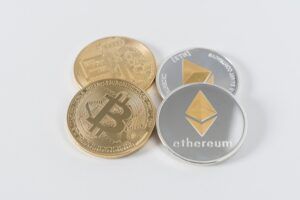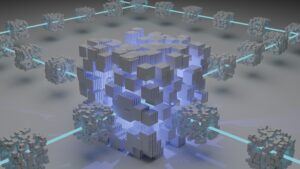You have probably heard of the terms cryptocurrency, bitcoin and blockchain. If not, you might be sitting there thinking; can someone explain how blockchain works! Well, keep reading to find out!
Blockchain is the technology that makes cryptocurrency possible. These might seem like strange terms, but they form the backbone of an entirely new and revolutionary currency system taking over the internet. A cryptocurrency is a digital means of exchange and makes use of encryption methods to control the creation of monetary units and their transfer through the ecosystem.
What is a Blockchain?
A blockchain is a decentralized ledger of all transactions that are taking place in a peer-to-peer network. It can be compared to a record of all the seeders and leechers taking part in a torrent download.
The only difference is that the transactions in the blockchain are monetary and encrypted, while the torrent download is unencrypted. With the use of blockchain technology, the participants can confirm transactions in a decentralized manner which means that the need for a central clearing authority is eliminated. The main areas where blockchain can be used include settling trades on the stock market, transferring funds, voting, and many other applications.
What is Cryptocurrency?

This form of exchange is created and stored in a purely electronic form in the blockchain. It uses encryption techniques to control the creation of monetary units that are known as new blocks on the blockchain and confirm transactions as they take place.
Bitcoin is one of the best examples of a cryptocurrency in wide use across the internet. Cryptocurrency only exists on the network, and as such, it has no physical form. The supply of the currency, in this case, does not get controlled or determined by a central bank since the network has been designed to be completely decentralized.
Benefits of Blockchain
Blockchain technology has several benefits, such as:
- Increased transparency
- Accurate tracking
- Permanent ledger
- Reduced costs of transactions
The distributed nature of this system means that it can be used more cost-effectively since the participants are in charge of all the different aspects of keeping the blockchain working and verifying transactions as they take place. It is also secured by encryption technology, which means that anyone who uses it is confident of the anonymity of their transactions and the security of all the information that gets transferred across the blockchain.
A New Territory
In addition to these benefits, blockchain technology is relatively new and largely unexplored. This means that it has a lot of unknowns that are yet to be determined. The unknowns include:
- The technology that powers the blockchain is complex, and operating it is incredibly difficult. A whole load of rules has to be factored into the design to make it transparent and usable for the entire network. The hardware in charge of the encryption also has to meet specific standards, meaning that the technology required to make use of the blockchain is still beyond reach for a lot of people.
- There are the regulatory implications of a decentralized currency with the government having no control over what the blockchain can and cannot do. As such, there are many third parties taking advantage of blockchain to fund illegal activities.
- There are also many challenges in the implementation of the technology since blockchain tends to involve a lot of encryption, and the standard for the currency can be hard to implement.
- Many other competing platforms promise the same features and benefits as blockchain, which means that the uptake and adoption of the system are also on the low end.
How Blockchain Works

Blockchain ensures that the entire network is transparent and honest in how it works. To begin with, someone requests a transaction. That transaction will be propagated to a P2P network of computers known as nodes.
The network of nodes is then used to validate the transactions and the status of the different users by using tried and proven algorithms that are reliable and effective for maintaining the network of nodes and their integrity. The verified transaction can be anything from a database entry to a contract or currency movement on the blockchain.
Once the network nodes have verified the transaction, it becomes part of the distributed ledger and is combined with the other transactions. It usually takes the form of a block that will be added to the rest of the blockchain in a permanent and unchangeable manner. Just as simple as that, and the entire transaction is complete.
Potential Applications of Blockchain
There are a lot of applications of blockchain technology that extend beyond cryptocurrency and bitcoin. It can be considered a business improvement software that can lower the cost of trust. A lowered cost of trust increases the ease with which business can take place, and as such, there is a higher return for each investment amount compared to a lot of other traditional investments.
Blockchain can, for instance, be used to process insurance claims at a lower cost than what modern providers of insurance services are capable of. It can also be used for scenarios where frictional ownership is the best way to contribute toward something.
Future Uses of Blockchain
It provides for cheaper, faster payments, which could reduce the transaction costs involved in many of the payments we make each day. Additionally, blockchain also has the impact of improving transparency, and as such, it is the most reliable means of exchange that we have today. In voting, blockchain technology could be used to cast votes digitally.
The results are immediately verifiable since the blockchain has verified all the transactions to the database in a real-time and more effective manner. Blockchain can also be used in healthcare to protect patient information confidentiality. The patient information is encrypted and can be shared with several providers without worrying about a breach of privacy.
As you can see, there are a lot of potential applications of blockchain technology, and it holds the potential to change the future of many things in our modern world. Databases will be more effective and payments much cheaper to effect, which results in a lower cost of living and better trust between entities in the information age.
I hope you found this article to be helpful and that you found it interesting. If you have any questions, we will be more than happy to answer them below.
All the best,
Pete
